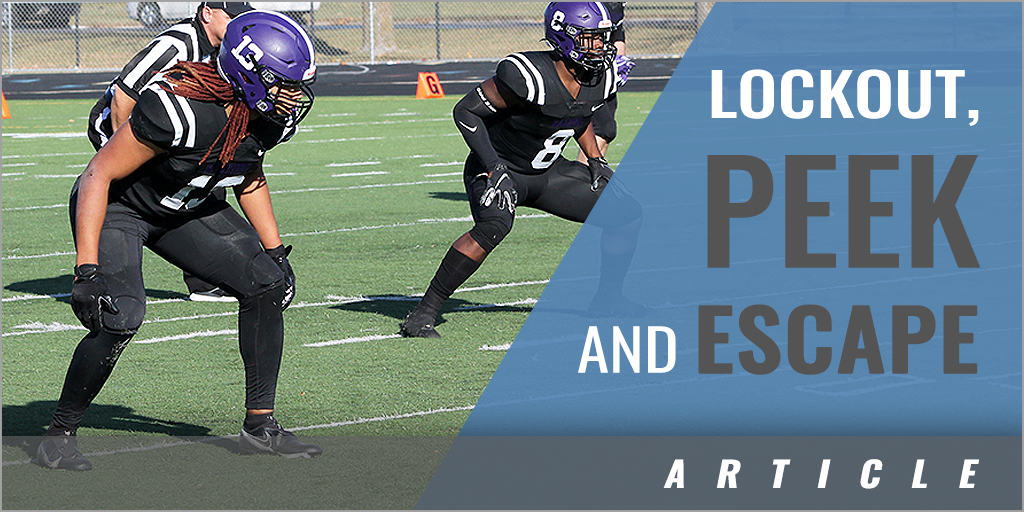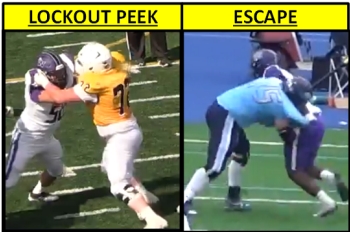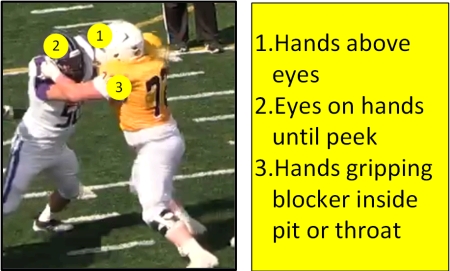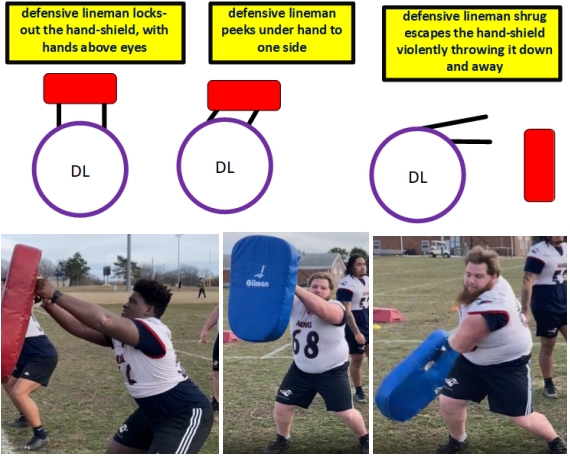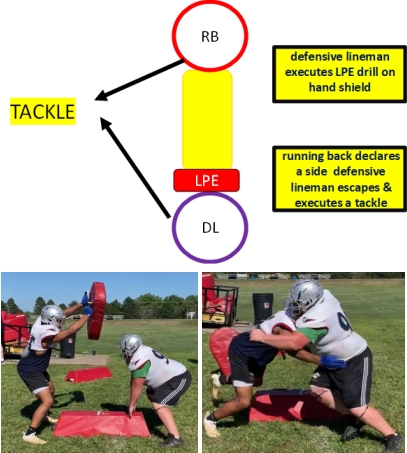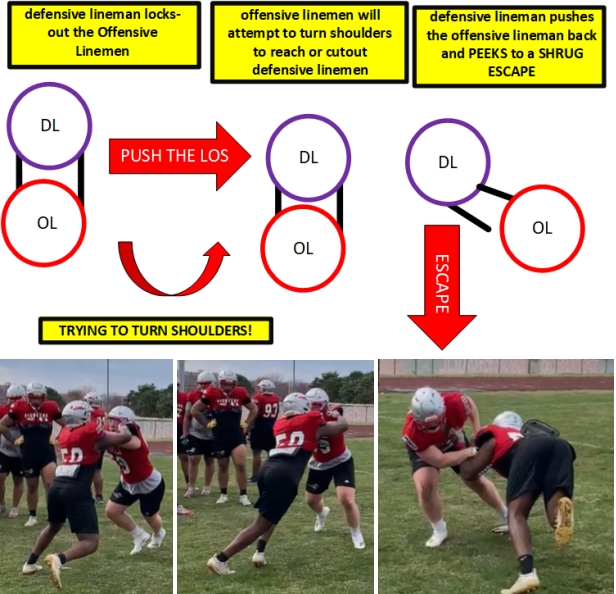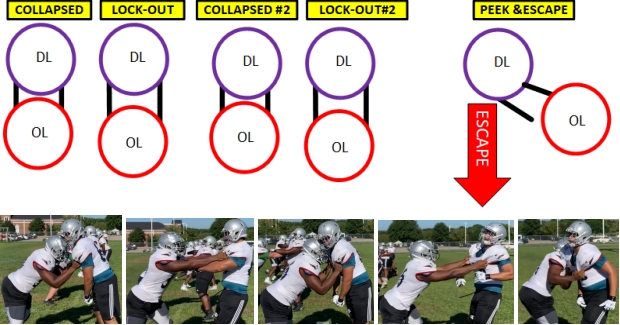|
By: Ben Brummer, Defensive Line Coach - Waldorf University (IA) The techniques of Lockout, Peek and Escape (LPE) are essential to the Waldorf Warriors' defensive line. In this article the main focus will be on the drills employed to progress defensive linemen through these specific skills. Description of Lockout, Peek and Escape techniques The skills of LPE are an essential tool to the success of the defensive lineman in defeating blocks and making an impact in the run game at or behind the line of scrimmage. The Lockout must be instant after the strike, powerful with hands above the eyes and arms fully extended. The Peek does not come until the athlete is locked out and must be quick. It is important to peek below the hands so the defensive lineman can maintain leverage. The peek is followed almost instantly with an Escape. The Escape must be fast and violent. The specific technique used to teach this is the shrug and arm over escape technique. The key to the shrug is to pull the offensive linemen down, face to the dirt, fast and away from the defensive lineman's path. The defensive lineman should turn their body to avoid offensive linemen on the ground, then snap back to square with the following step. If the shrug is unsuccessful in completely removing the offensive lineman from the block, specifically if the blocker maintains a grip on the chest of the defensive lineman, then it is time to employ the arm over escape technique. The elbow should break the wrist of the backside arm of the offensive lineman and the fist should break the front side wrist. This way, as the defensive lineman is escaping, the offensive lineman cannot maintain his grip on the defensive lineman's chest. The following drills discussed are used to build this skill set. It is important to note that variations of these drills can be used. The following therefore are not the only methods used, but are the central set of drills in which to teach these techniques.
Hand Placement and Eye Focus A vital part of this skill set and this progression is where the hands are placed. It is important to teach the athletes to get their hands above their eyes as that keeps their pads low, and gives them leverage on the offensive linemen. The goal is to keep the eyes fixed on the hands until it's time to peek. This keeps the lockout strong until it's time to peek escape. A huge focus in these drills is making sure the eyes are always in the right place, in both the lockout, Peek and Escape.
LPE Drill With Hand Shield The first drill in the progression is LPE with a hand shield. The main goal of this drill is to work the peek escape technique, focusing on the hand and body position and the violent shrug escape. Using hand shields is a great way to start teaching the technique for three reasons. First, the shields have handles on them allowing the athlete to drill gripping the blocker. Second, the shields are lightweight, so there is little hindrance in terms of reps wearing out the athlete as well as allowing them to emphasize the aggression in the shrug technique. Third, the drill can be assessed clearly. If the bag flies violently down and away, then the defensive lineman executed it correctly. When executing the drill the athlete always peeks under their hands to keep their pads low. Then once they decide to escape, the athlete is going to violently shrug the hand shield down and away from their desired escape route. There can be many different stimuli the coach can use to trigger the escape. They can use a running back, appearing in the line of sight of the defensive lineman, or they can have them escape on the coach's command. This drill is the starting point of the progression. Alternate equipment that can be used in this drill are sandbags or pop ups. Sandbags are great for building strength due to their weight. Pop ups are beneficial for speed and don't need to be reset in between each rep. Eventually the goal is to move to using real player bodies as often as possible. The steps for execution of the drill are as follows:
LPE Drill into a Leverage Tackle The next part of the progression is LPE with an open leveraged tackle drill. This is a great way to work the LPE drill while adding the most commonplace tackle a defensive lineman gets, the in gap tackle on the ball carrier. Executing this drill still requires the LPE drill previously discussed, but adds in the elements of tackling the ball carrier and avoiding the body of the offensive lineman. In addition, this drill can be expanded to include a scenario in which the defensive lineman peeks through one gap, and then the running back hits the gap on the opposite side forcing the athlete to work on escaping back across the offensive linemen to make the play The steps for execution of the drill are:
Steer Drill The third progression following the two prior drills is the Steer Drill. This drill consists of working LPE skills while an offensive linemen is trying to reach or cut the defensive lineman out of the desired gap for escape. Now the athlete is working the LPE with a moving offensive lineman and needs to maintain his leverage and keep his shoulders square with the offensive lineman's in order to maintain the edge of the line of scrimmage. The player simulating the offensive lineman in this drill will be turning his shoulders to try to reach or cut off the defensive lineman out of his gap. The goal of the defensive lineman should be to push the line of scrimmage and keep the shoulders squared. Once it is time to Peek and Escape the athlete will work a full shrug arm over escape on the offensive lineman, violently throwing them to the ground. The drill will begin with the two athletes engaged, and while the offensive linemen will be attempting the reach and turning of defensive linemen’s shoulders, the defensive linemen will then lockout the arms while pushing the offensive linemen backwards. Once the defensive linemen has knocked the offensive linemen off the line of scrimmage, and has peeked with square shoulders, he can then work the escape. The steps for execution of the drill are:
Ragdoll Drill As a coach it is important to realize that it is not realistic to expect that a technique, no matter how effective and well taught, is going to be deployed or successful one hundred percent of the time. The offensive line is likely coached to counteract these skills, so it is best to provide techniques for when these skills fail. That is what the last progression of the LPE skills is for. The Ragdoll Drill works the technique of relocking out so the athlete can peek escape when his arms get collapsed, or when he doesn't get locked out after the initial strike. For this drill the defensive lineman will partner up and start out collapsed with one player simulating an offensive lineman. The offensive lineman will put all his weight on the defensive lineman. The defensive lineman will then lockout as violently as possible, and then he will re-collapse his arms and repeat the violent lockout. After the second lockout the defensive lineman will then finish with a peek and a violent shrug arm over escape. The steps for execution of this drill are:
As previously discussed, this skill set can be installed through a series of drills to bring a complete understanding of the execution and application of the Lockout, Peek and Escape techniques. The base LPE drill teaches the athlete the physical movements of the skill set. The LPE Leverage Tackle Drill teaches the athlete to employ LPE and finish with an in gap tackle. The Steer Drill teaches to maintain shoulder position and the use of LPE while moving feet and preventing the offensive lineman from reaching the defensive lineman out of the gap. The Ragdoll Drill teaches the defensive lineman how to recover when their arms get collapsed, and get to lockout so the athlete can still execute the peek and |
